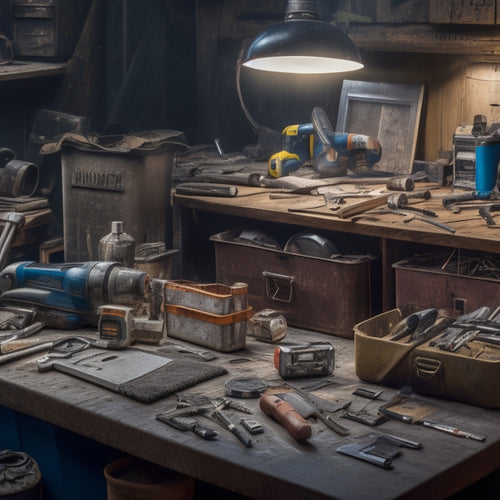
Toolbox Checklist for Repair and Renovation Success
Share
When tackling repair and renovation projects, having the right tools and a well-organized toolbox is essential for success. You'll need essential tools like a hammer drill, mixing bucket, and curing compounds for concrete repair, as well as specialty tools like a scarifier and crack injection kit for unique repairs. A sturdy tool storage system with adjustable compartments and secure closures will keep your tools protected and within reach. Organize your toolbox by designating tool homes, labeling compartments, and prioritizing frequently used tools. By prioritizing safety features like personal protective equipment, emergency equipment, and training, you'll set yourself up for a safe and successful project - and that's just the starting point.
Key Takeaways
• Ensure you have essential tools like hammer drills, mixing buckets, and curing compounds for efficient concrete repair.
• Choose a durable and adjustable tool storage system with secure closures and comfortable handles for easy transport.
• Organize your toolbox by designating tool homes, labeling compartments, and prioritizing frequently used tools for quick access.
• Consider adding specialty tools like scarifiers, crack injection kits, and epoxy injection guns for unique repair tasks.
• Always prioritize safety features like personal protective equipment, emergency equipment, and respiratory protection to prevent injuries.
Essential Tools for Concrete Repair
When tackling concrete repair, you'll need a solid arsenal of tools to guarantee a successful and long-lasting fix, starting with a reliable hammer drill. This versatile tool will allow you to efficiently drill into the concrete, making it easier to remove damaged areas and prepare the surface for repair.
Next, you'll need a mixing bucket and mixing paddle to combine the repair material according to the manufacturer's instructions. Proper mixing techniques are vital to ensure a strong and durable bond.
Don't forget to have a supply of curing compounds on hand, as these will help to seal the repaired area and prevent water infiltration.
Additionally, a trowel or putty knife will come in handy for applying and smoothing out the repair material.
Finally, a level and straightedge will help you achieve a professional-looking finish.
Checklist for Buying Concrete Repair Tool Storage
You'll need a reliable tool storage system to keep your concrete repair tools organized, protected, and within easy reach, ensuring you can respond quickly to any project demands. When selecting a storage solution, reflect on the size and weight of your tools, as well as the frequency of use.
Look for storage solutions that prioritize tool durability, such as rust-resistant and water-resistant materials. Contemplate a storage system with adjustable compartments and dividers to customize the layout to your specific needs. Additionally, think about the mobility of your storage solution – will you need to transport it to different job sites or keep it in a fixed location?
When evaluating storage solutions, don't forget to reflect on the little things, such as easy-open latches, secure closures, and comfortable carrying handles. A well-designed storage system won't only protect your tools but also save you time and frustration on the job.
Organizing Your Toolbox Efficiently
Now that you've selected a reliable tool storage system, it's time to optimize its organization by categorizing your concrete repair tools into functional groups, such as finishing, cutting, and drilling, and allocating specific compartments for each. This will allow you to quickly locate the tools you need, saving time and increasing productivity.
To guarantee effective tool organization, follow these steps:
-
Designate a home for each tool: Assign a specific place for each tool, making it easier to find and return them after use.
-
Label each compartment: Clearly label each compartment, so you can quickly identify where each tool is stored.
-
Store frequently used tools front and center: Place your most frequently used tools in easy-to-reach locations, reducing the time spent searching for them.
- Schedule regular toolbox maintenance: Set aside time to clean and maintain your toolbox, ensuring it remains organized and functional.
Specialty Tools for Unique Repairs
Your concrete repair toolkit isn't complete without specialty tools designed to tackle unique repair challenges, such as scarifying, crack injection, and epoxy injection. These tasks require precision and accuracy, making it vital to have the right tools for the job.
Here are some specialty tools you should consider adding to your toolkit:
| Tool | Description |
|---|---|
| Scarifier | Removes surface imperfections and prepares concrete for repair |
| Crack Injection Kit | Injects epoxy or polyurethane into cracks for a durable bond |
| Epoxy Injection Gun | Delivers precise amounts of epoxy for accurate repair |
| Specialty Hammers | Designed for specific tasks, such as chiseling or tapping |
| Precision Measuring Tools | Guarantees accurate measurements for precise repairs |
With these specialty tools, you'll be equipped to tackle complex repair challenges with confidence. Remember, having the right tools can make all the difference in achieving professional-looking results. Take the time to invest in your toolkit, and you'll be rewarded with successful repairs that stand the test of time.
Safety Features to Consider
Proper safety equipment and protocols are essential to preventing injuries and ensuring a successful renovation. Incorporating these vital safety features into your toolkit is an important step in the process. You shouldn't take any chances when it comes to your well-being and the well-being of those around you.
Here are four essential safety features to take into account:
-
Personal Protective Equipment (PPE): This includes items like hard hats, safety glasses, earplugs, and gloves. Make sure you have the right PPE for the task at hand.
-
Emergency Equipment: A first aid kit, fire extinguisher, and emergency phone or two-way radio can help in case of an unexpected event.
-
Respiratory Protection: If you're working with hazardous materials or in confined spaces, consider investing in a respirator or mask to protect your lungs.
- Fall Protection: If you're working at heights, a harness or safety net can be a lifesaver.
Frequently Asked Questions
Can I Use a Single Toolbox for All My Repair and Renovation Projects?
You can use a single toolbox for all your repair and renovation projects, but it requires strategic toolbox organization to guarantee multi-project versatility, allowing you to efficiently access and switch between tools for different tasks.
How Often Should I Clean and Maintain My Toolbox and Tools?
You should clean and maintain your toolbox and tools regularly to guarantee tool organization and extend tool longevity; aim to organize and clean your tools after each use, and perform deep cleaning and maintenance every 1-3 months.
Are There Any Specific Tools for Working With Certain Materials Like Wood or Metal?
When you're trying to shape a piece of wood into a work of art, you wouldn't use a hammer; just as you need specific brushes for painting, you'll need woodworking tools like chisels and hand saws, and metalworking tools like drill bits and files, to tackle unique materials effectively.
Can I Borrow Tools From Friends or Family Instead of Buying Them?
When borrowing tools from friends or family, you'll want to establish clear tool sharing agreements and follow proper borrowing etiquette, ensuring you return tools in good condition and on time to maintain healthy relationships.
Do I Need to Invest in a Toolbox With Wheels for Easier Mobility?
"You're not exactly hauling a grand piano, but a wheeled toolbox can be a lifesaver, literally! With features like sturdy handles and smooth-rolling wheels, you'll appreciate the mobility advantages when lugging heavy tools around the job site."
Conclusion
As you commence your repair and renovation journey, remember that a well-stocked toolbox is your trusty steed, carrying you through the most treacherous of tasks.
By following this checklist, you'll be well-equipped to tackle even the most intimidating projects.
Your toolbox, now a veritable treasure trove of efficiency, will be the key to revealing success.
So, saddle up and get to work – your next project awaits!
Related Posts
-

Smart Guide to Buying Second-Hand Renovation Tools
When buying second-hand renovation tools, you'll want to set clear renovation goals and a realistic budget to priorit...
-

What Plastering Tools Do You Need for Renovation
You'll need a range of specialized tools to tackle a plastering renovation project efficiently and effectively. Essen...
-

Streamline Your Exterior Renovation Timeline
To streamline your exterior renovation timeline, you'll need to approach the process strategically. Start by planning...


